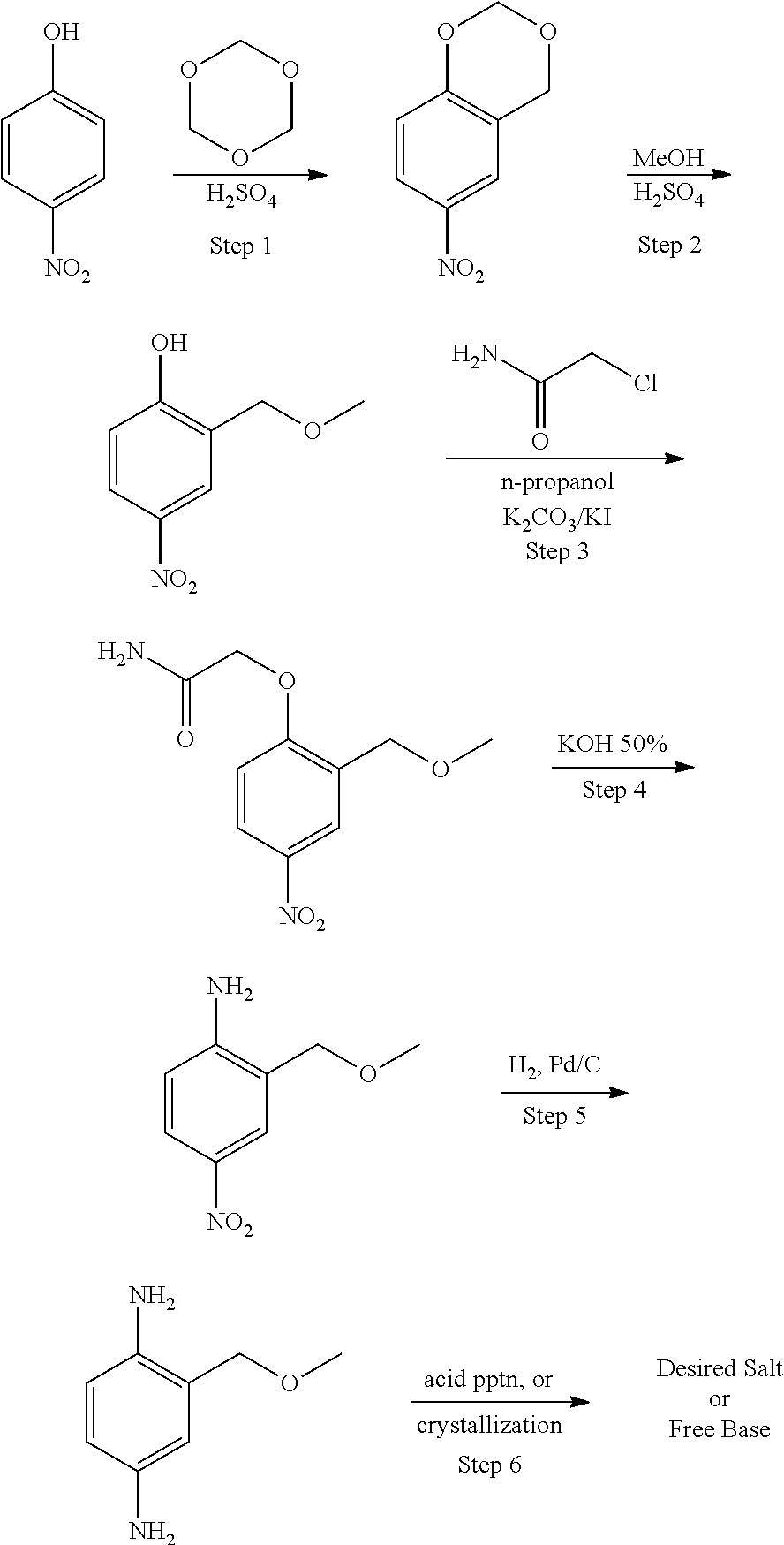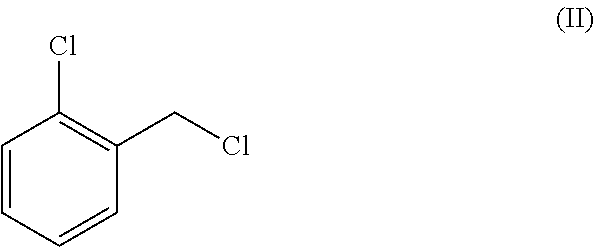Methods of Synthesizing 2-Methoxymethyl-1,4-Benzenediamine
a technology of benzenesiamine and 2-methoxymethyl, which is applied in the field of synthesis of 2methoxymethyl1, 4benzenesiamine, and can solve the problems of lower overall mbb yield and higher manufacturing cost when compared
- Summary
- Abstract
- Description
- Claims
- Application Information
AI Technical Summary
Benefits of technology
Problems solved by technology
Method used
Image
Examples
example 1
Preparation of 2-methoxymethyl-1,4-benzenediamine
Step 1: The Nitrating Step
[0023]Step 1 details the preparation of 4-nitro-2-chloromethyl-chlorobenzene. 50.0 g (0.3 μmol) of 2-chlorobenzyl chloride is dissolved in 141 ml of concentrated sulfuric acid and cooled in an ice / methanol bath to an internal temperature of −5° C. 20.66 g (0.328 mol) of fuming nitric acid is placed in an attached addition funnel. The nitric acid is added at such a rate as to keep the internal temperature below 0° C. Near the end of the reaction the product crashes from the solution and stirring ceases. Thin layer chromatography (“TLC”) analysis indicates the reaction is, nonetheless, complete. The reaction mixture is poured over 750 ml of ice in a 1 L Erlenmeyer flask. Additional ice is added to keep reaction cold. The cold reaction is allowed to stand so that the solids settle. The supernant is poured off. The solid is triturated one additional time with 250 ml water. The final solid is taken up in 400 ml di...
embodiment a
Alkali Methoxide
[0025]15.0 g (72.8 mmol) of 4-nitro-2-chloromethyl-chlorobenzene are stirred in 50 ml of anhydrous methanol. At room temperature, 13.9 g of a of a sodium methoxide solution (30% in methanol) is added. In the course of the addition, sodium chloride precipitates out and a colorless to rose-colored suspension is obtained. The addition of the sodium methoxide solution is finished after 30 minutes, whereas the internal temperature rises to approximately 30° C. Then the reaction mixture is heated for 30 minutes under reflux, and the suspension is filtered hot to obtain a clear solution. Upon cooling, the product, 4-nitro-2-methoxymethyl-chlorobenzene, crystallizes out and is filtered off. The product yield is 11.0 g of a yellowish solid. The filtrate is concentrated to approximately half of the volume and cooled in an ice bath to give another 3.8 g of product. The total product yield is 14.8 g.
[0026]1H-NMR (DMSO-d6): 8.27 (d), 1H, 8.18 (dd), 1H, 7.77 (d), 1H, 4.58 (s), 2H,...
embodiment b
[0027]180.0 g of 4-nitro-2-chloromethyl-chlorobenzene are stirred in 450 ml of anhydrous methanol. After heating to reflux, a prepared solution of 41.9 g of sodium hydroxide in 270 ml of methanol is added over a period of one hour. In order to complete the reaction the mixture is stirred under reflux for an additional hour. In the course of the addition, sodium chloride precipitates out and a yellowish suspension is obtained. After completion of the reaction, the suspension is cooled in an ice bath. Under continuous cooling at less than 10° C., a solution of 90 ml acetic acid in 540 ml water is added within 15 minutes. After addition, the suspension is stirred in an ice bath for an additional 30 minutes. Finally, the reaction product, 4-nitro-2-methoxymethyl-chlorobenzene, is filtered off and washed with a mixture of water and methanol (9:1). The product is dried at 40° C. The product yield is 165.4 g.
Step 3: The Benzylamine Step
[0028]Step 3 details the preparation o...
PUM
| Property | Measurement | Unit |
|---|---|---|
| temperature | aaaaa | aaaaa |
| temperature | aaaaa | aaaaa |
| pressure | aaaaa | aaaaa |
Abstract
Description
Claims
Application Information
 Login to View More
Login to View More - R&D
- Intellectual Property
- Life Sciences
- Materials
- Tech Scout
- Unparalleled Data Quality
- Higher Quality Content
- 60% Fewer Hallucinations
Browse by: Latest US Patents, China's latest patents, Technical Efficacy Thesaurus, Application Domain, Technology Topic, Popular Technical Reports.
© 2025 PatSnap. All rights reserved.Legal|Privacy policy|Modern Slavery Act Transparency Statement|Sitemap|About US| Contact US: help@patsnap.com



